The Dell Venue 11 Pro 7000 Review
by Brett Howse on April 16, 2015 8:00 AM EST- Posted in
- Tablets
- Dell
- Windows 8.1
- Core M
Battery Life
Battery life is one of the critical elements to any mobile device, especially one such as a tablet. Notebooks can easily be used from desk to desk, but for a tablet, mobility is king. If it was not, you likely would not want a tablet.
The Venue 11 Pro is somewhat different in that it is a tablet first and foremost, but is also offered with a keyboard dock which basically turns it into a laptop. It offers Connected Standby support like other Windows tablets, but on the inside are parts which are more often found in Ultrabooks. For this reason both tablet battery life and laptop battery life was tested.
The Venue 11 Pro comes with an integrated 38 Wh battery. The keyboard dock includes an integrated battery as well which is around 24 Wh, so that combined the total is about 62 Wh of battery capacity.
As always, our devices are standardized to 200 nits of brightness for all battery life tests.
Tablet Battery Life
First off, the Venue 11 Pro needs to be tested as what it is – a tablet. For this we have tested the device with our tablet browsing test, which is less demanding than the one we use on laptops.
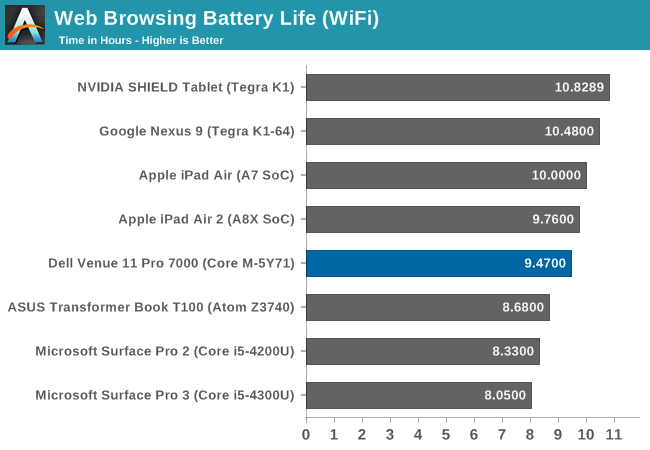
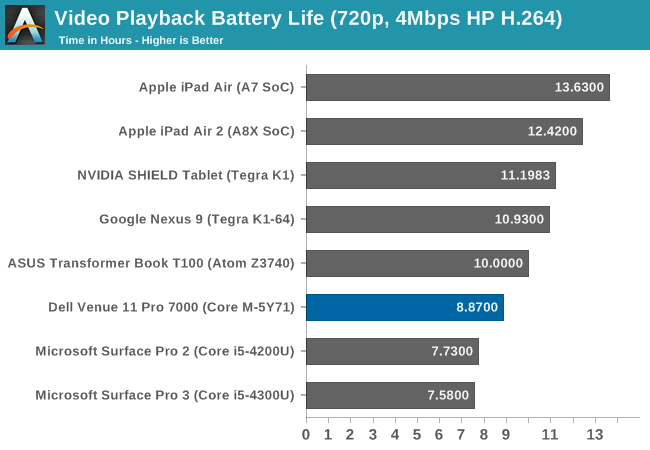
Tablet battery life is actually quite good, coming in just under the iPad Air 2 in our Wi-Fi test. It is of course helped by its much larger battery than the average tablet. For example, the iPad Air 2 has a 27.62 Wh battery versus 38 Wh in the Dell. Video playback time is not quite as impressive even though it does have hardware support for the video decode. The hardware and software for video playback on the ARM devices seems to be a bit more tuned. Tablets need to be mobile, so the Venue 11 Pro's larger battery helps it deliver competetive overall battery life.
Laptop Battery Life
When docked to the keyboard accessory, the tablet can be used as a laptop replacement. It is a very small laptop mind you, but it can be used this way if needed.
With Core M, a reasonable resolution, and a relatively big battery, hopes are that this unit will deliver on the battery front. As with our tablets, all battery testing is done at 200 nits to have a consistent performance level for the display, and for the notebook tests, the Dell Venue 11 Pro was docked to the Mobile Keyboard to increase the total battery size to 60 Wh.
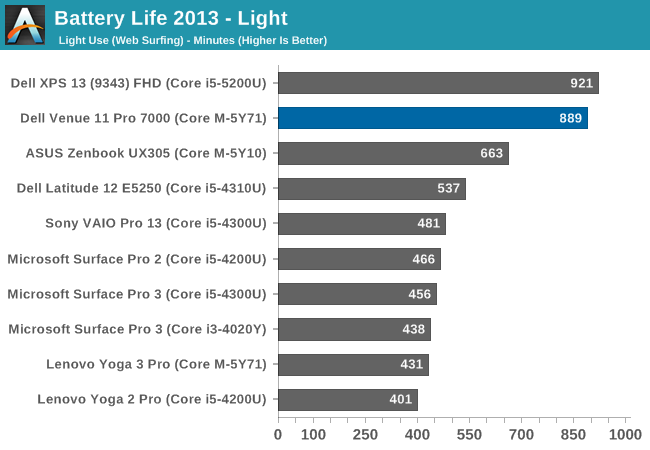
The Venue 11 Pro can deliver some pretty amazing battery life, coming in at almost fifteen hours of use. Not too many devices can deliver this on our light test, which consists of just web browsing over Wi-Fi.
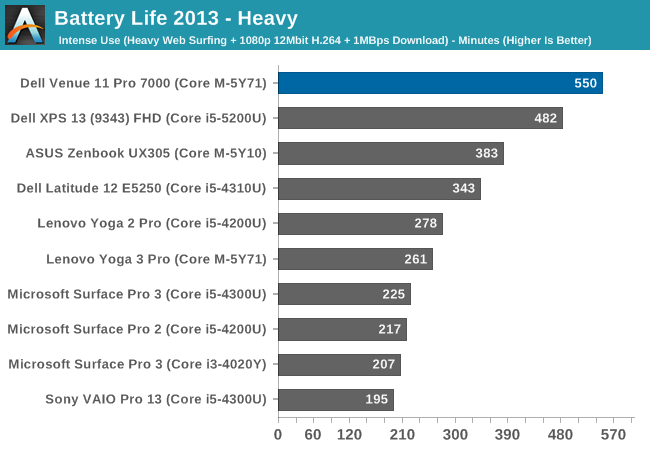
With an even larger battery than the Dell XPS 13, the same resolution display, and Core M, the Venue 11 Pro can easily deliver all-day battery life even when put through our heavy test. It is a very impressive result. 2015 seems to be the year of battery life, and the results are very much welcome.
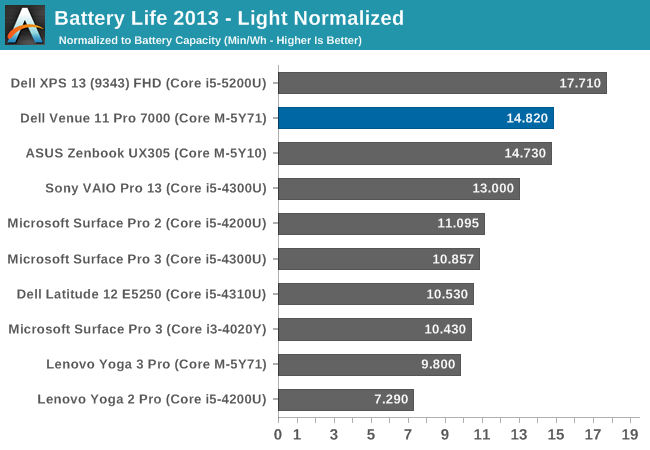

Next, the devices have the overall battery life divided by the battery capacity to give a feel for overall platform efficiency. Here the Venue 11 Pro does very well again, scoring almost at the top. As a system, the Venue 11 Pro is very efficient, and that is backed by a larger than normal battery when docked to the keyboard, which makes for a very mobile device.
Charge Time
Battery life is of course just one side of the mobile equation. The time to charge can also play a big factor especially when travelling. Dell ships the Venue 11 Pro with a 24 watt adapter, which has micro USB in order to charge both the tablet and the keyboard. This is not a huge amount of power, but it does keep the adapter on the small side to make it easier to bring with you.
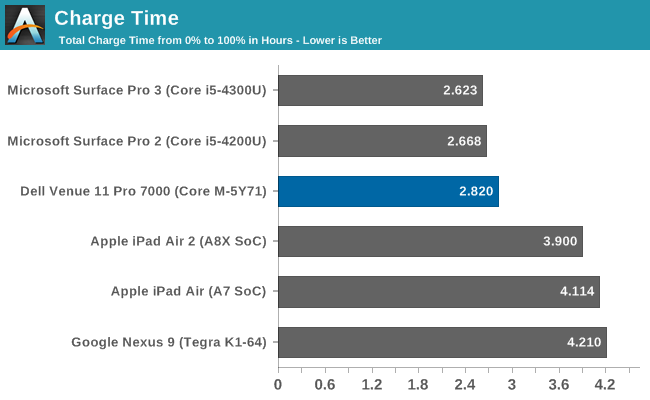
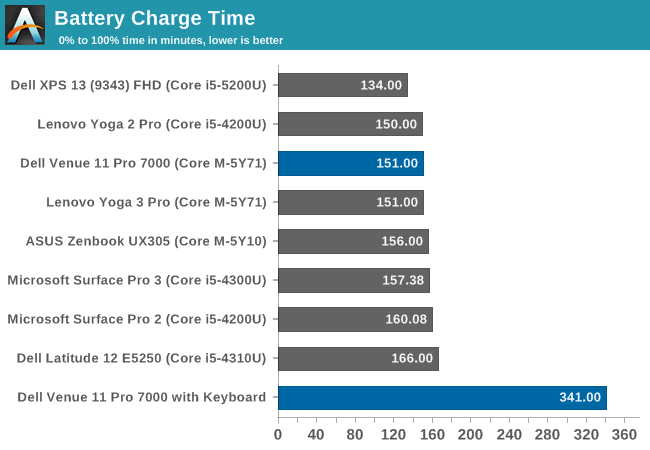
Just charging the tablet takes 2:49, which is a bit long when compared to a laptop, but a good score when compared to a tablet. It is almost the opposite of what you would expect though, since it has a small battery for a notebook, and a large battery for a tablet. So obviously Dell has made a good compromise here.
Once you add in the keyboard though, the charge times get pretty high. Charging both devices at the same time results in a 5:41 charge time, which is well over what most notebooks will do. The micro USB cable plugs into the tablet, which then charges the keyboard, at least in this scenario. I can understand why Dell has done this, but it does make for a long time to get to 100% charge. If needed, the keyboard can be charged on its own but only with the tablet detached since the charging connector is in the slot where the tablet would normally be.
Charge Rate Tablet Only
Venue 11 Pro Charge Rate with Keyboard Attachment
This graph is (at least to me) very cool. Obviously some thought has gone into how to charge the two batteries, and the priority is on the tablet battery. Once you hit 80% though, the tablet battery would normally taper off until it gets to 100%, but the second battery charges to 80% instead, and then each charges the rest of the way until the device is fully charged. The overall time could go down if both devices could charge at the same time, but that would likely require a lot more circuitry.
The docking station does include a 65 watt charger, so I hoped that this would increase the charge rate and therefore decrease the time to charge, but unfortunately this is not the case.


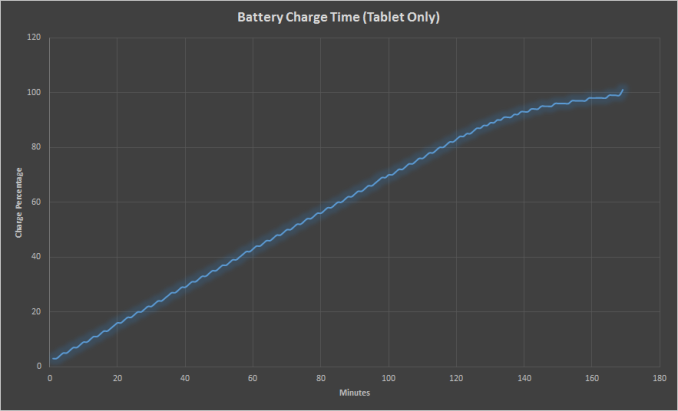
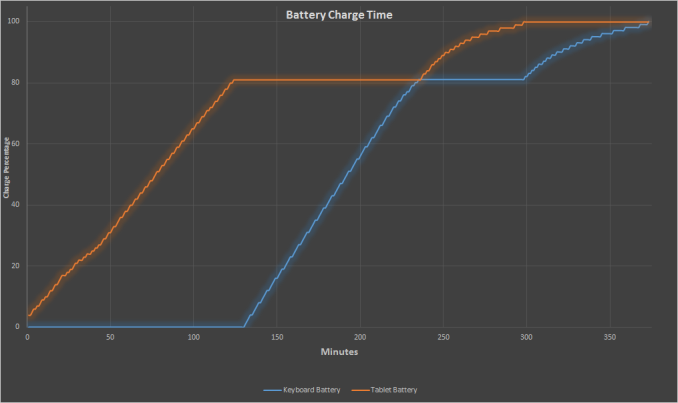








92 Comments
View All Comments
MrSpadge - Thursday, April 16, 2015 - link
Well Said! I'm not going to buy Core M because I value performance over mobility - yet this doesn't make it a bad product. If you want maximum performance at high mobility, nothing comes close to Core M.dj_aris - Thursday, April 16, 2015 - link
Core M is in fact a new cpu category on it's own, a cpu that resembles the single core performance of "core" cpus while in the Atoms' TDP envelope (at least before it throttles!). But, as with every new product, it's overpriced at launch. Wait for the Skylake release, I say.lilmoe - Thursday, April 16, 2015 - link
That's the main point. It's REALLY overpriced.xthetenth - Thursday, April 16, 2015 - link
Pay a pretty high price for the absolute best burst performance for a snappy device. I've heard much worse than that.smilingcrow - Thursday, April 16, 2015 - link
The M-5Y71 is the same price as the i5-4300U in my laptop with the same base & turbo boost clocks for the CPU. Given the same cooling as my laptop has it should perform very similarly for CPU loads. Not fussed about GPU loads so haven't focussed on that but seemingly it will struggle to match the U series when both are stressed.Marc GP - Thursday, April 16, 2015 - link
A category where they can only keep this performance for short bursts before having to low their frequency from 2,8Ghz (turbo) to their nominal 1Ghz (where you don't get any much performance than on a simple Atom).ppi - Thursday, April 16, 2015 - link
Even in the benchmarks, where sustained performance is necessary, Core-M is some 25% slower compared to 15W Broadwell. ONLY.This effectively means, that if task is pain on Core-M, it will be pain on 15W Broadwell as well. I.e. if some task is not snappy and requires waiting on Core-M, it requires waiting on Broadwell as well. And only desktop class chips may have the oomph to be significantly faster.
I do not count in games, but nobody considers Broadwell-U gaming SoC either.
smilingcrow - Thursday, April 16, 2015 - link
If you had read the recent detailed Anandtech overview of Core M you would see that is a fallacy. I was surprised how well Core M does in a fanless laptop versus one with a Broadwell i5 that is fan cooled. And even more how well it does in a tablet where surface temperate is more of an issue so throttling is more prevalent.A Core M-5Y71 in my Latitude E7440 with a slightly beefier cooler would I imagine come close to my i5-4300U even for extended loads. This is purely for CPU loads as the GPU is another issue that doesn’t concern me.
MrSpadge - Thursday, April 16, 2015 - link
When it throttles it's actually entering Atoms TDP envelope. Before that it's allowed to use more power for short periods. That's the whole point of a Thermal Design Power.zepi - Thursday, April 16, 2015 - link
If you don't care about absolute performance, Intel is happy to sell you a Baytrail for quite a bit cheaper.If you do... Well, no one else can match Core M's CPU-performance even remotely.